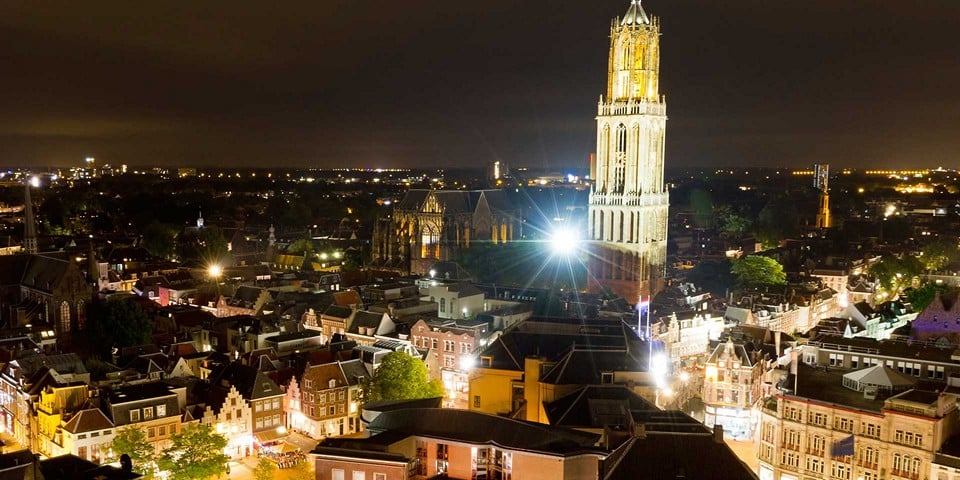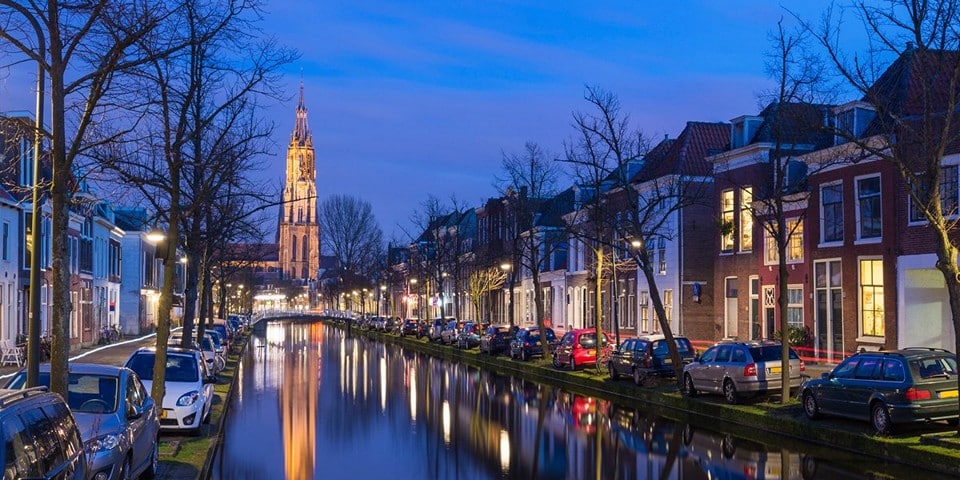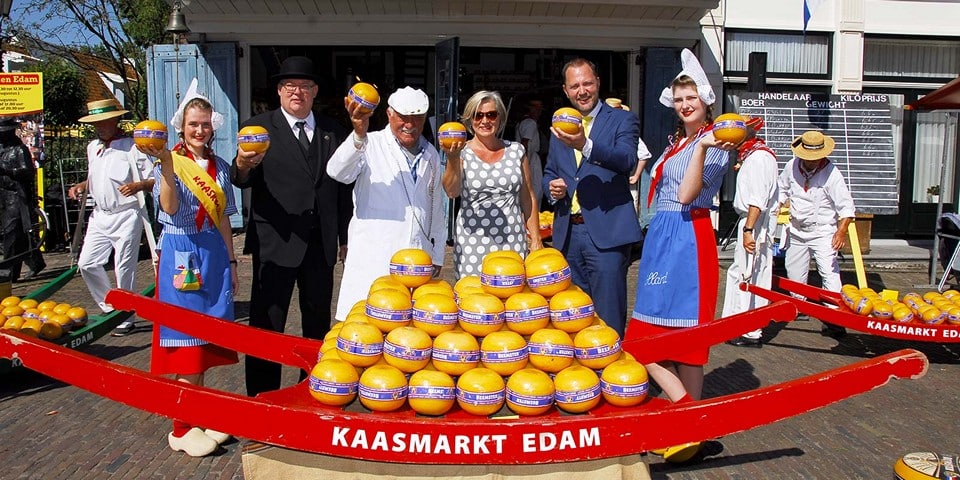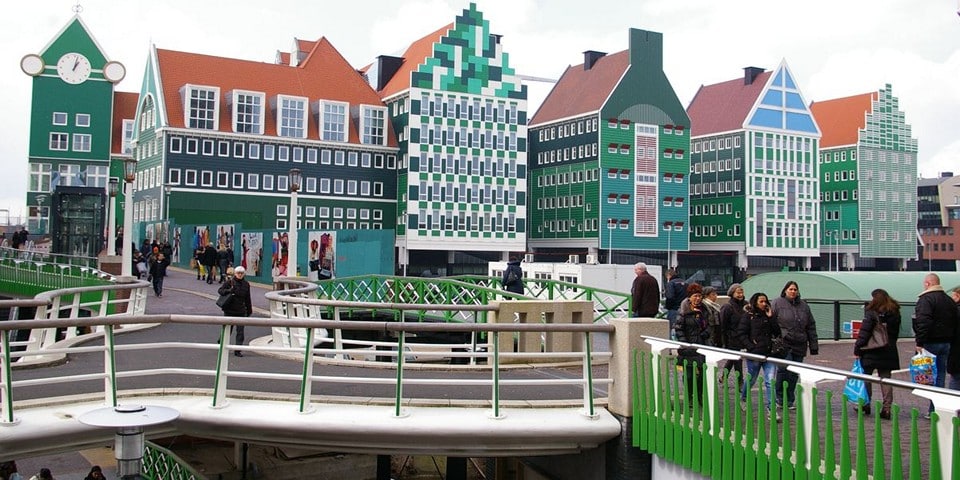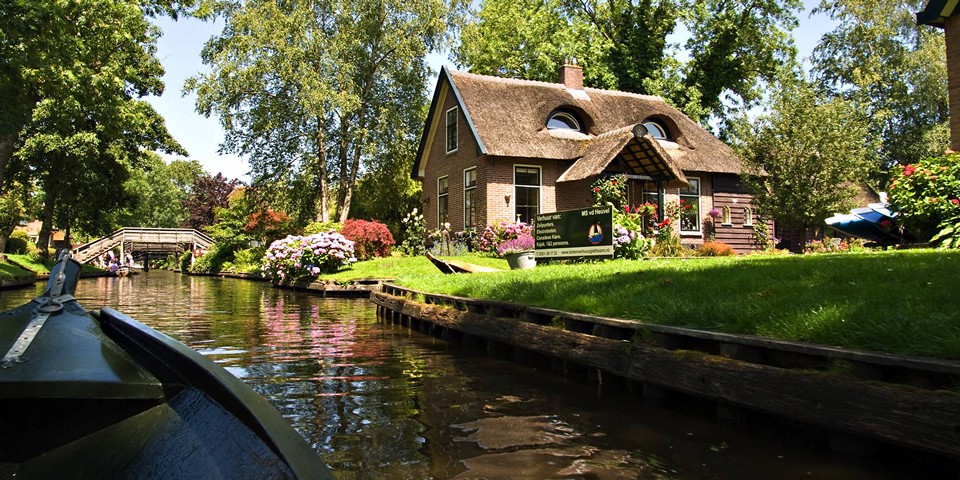Utrecht is one of the oldest and youngest cities in the Netherlands (Nederland). Old, because it was founded by the Romans in the first century AD. Young, because more than a quarter of the city's population are students. That's why concerts, festivals, and musicians play on every corner in the warm season.
Geography
Utrecht is located in the central part of the Netherlands, is the administrative center of the province of the same name, where an area of 100 km2 is inhabited by 312.6 thousand people. From Amsterdam, the capital, Utrecht is 53 kilometers to the southeast.
Utrecht is crossed by the Oude Rijn, one of the branches of the Rhine (Rijn), which flowed through the city a thousand years ago. The part of the Oude Rijn that flows through Utrecht is called the Amsterdam-Rijnkanaal (Amsterdam-Rijnkanaal). It is the city's central canal, connecting Amsterdam to the main Rhine shipping lane, and is also the link between the Dutch capital and the German Ruhrstadt.
A little north of the city, the Vecht River flows through the city. Accordingly, the canal through which it flows is called Vechtdijk. One of the branches of the Aude-Rhine is the 13 km long Leidse Rijn canal, which flows out of the city from the west side.
In the north of Utrecht is the largest lake of the city - Haarrijnseplas, which has an area of 90 hectares. The center of the lake is crossed by the Maarssenseweg road. In the south of Utrecht is Lake Nedereindse Plas.
Compared to Amsterdam, Utrecht has few canals. Nevertheless, they have their own special feature: many of them are two-tiered. That is, the river at these sites is as if deepened into the ground. At the bottom, almost at the water's edge, there are various cafes and tables for recreation. On the second tier is the city itself, with its houses and attractions. Such a non-standard solution helped protect the city from many floods.
- I advise you to read: Where to stay in Utrecht
History
Utrecht was founded by the Romans in the first century AD on the site of a settlement of the Batavians, an ancient Germanic tribe. Once the territory was occupied, soldiers on the banks of the Rhine erected a fortress with a garrison of five hundred soldiers. The fort had an important defensive value: the northern border of the Roman Empire passed here. The riverbed has since shifted, and the site of the former fortress is now the Domplein square (Domplein) and the city's main cathedral (Dom van Utrecht).
At the same time the name of the settlement appeared. Presumably, the name "Utrecht" came from the Latin "Traiectum", which means "crossing". Over time, the word was shortened to Trecht, and then acquired the letter "y" at the beginning. There are other interpretations of the city's name. Some linguists argue that the word "Utrecht" comes from the Old Dutch UUT, which means "downstream".
In the second century Germanic tribes began to aggressively assert their presence, forcing the Romans to abandon the fortress in 270 AD. After that the fort changed hands several times until it was finally destroyed. In the 6th-8th centuries Utrecht was a major stronghold. Utrecht was one of the major settlements of the Frisian Kingdom (Magna Frisia), and at the end of the 7th century there was set up a residence of a bishop. Thanks to its favorable location Utrecht has always had an important trading value, and in 1122 it officially became a city.
Utrecht was an important Catholic center from 650 to 1528. The importance of the settlement as a Christian center of northern Europe is illustrated by the fact that in 1522 a local native, Adrian VI, became pope. However, he did not rule for long and died a year and a half after his election.
In the early 16th century the bishop lost secular power over Utrecht - and it passed to Charles V, Holy Roman Emperor, whose center was in Germany. In 1579 the northern provinces of the Netherlands entered into an alliance in Utrecht against the Spaniards, which was the beginning of the unification of the Dutch regions into one republic (the Utrecht Union).
From then until the beginning of the 19th century, the city saw many clashes between different political forces. In 1723 the city became the center of Old Catholicism, which is something between Catholicism and Protestantism. In the nineteenth century, Utrecht was no longer on the brink of military clashes, and began to develop quietly. It is now a major industrial, railroad, scientific and cultural center of the Netherlands.
- What is a must-see in Utrecht in one day?
Attractions
Utrecht is a very beautiful city. In the historic center there are many architectural monuments, and a special highlight are the two-tier canals, which do not exist even in Amsterdam.
Many facades, alleys and bridges are decorated with light illumination, so that in the evening you can watch a real light show.
The main attraction of the city is Utrecht Cathedral and its bell tower Domtoren, rightly considered a symbol of the city.
Also interesting is "Paus huis" - the residence of Hadrian VI, built by order of the Pope in the 16th century. South of the Cathedral Square (Domplein), located museum quarter, where there is a lot of interesting expositions. Among the exhibitions are the Museum of jukeboxes, located in the oldest church in the city, Sonnenborg Observatory, and the Central Museum.
- For more comfortable sightseeing I recommend planning an overnight stay at one of the hotels in Utrecht.
Utrecht Cathedral
St. Martin's Cathedral (Dom van Utrecht) was built in 695 by the first bishop of Utrecht. It stood for two centuries and was destroyed during one of the Viking raids. In the X century the church was rebuilt, after which it became the main temple of the city. Since then it has burned and been destroyed many times, but it has always been rebuilt.
The current building was begun in the 13th century after a fire that destroyed most of Utrecht. The construction was delayed and did not end until the beginning of the 16th century. That's why it happened that Catholics began to build the cathedral, Protestants finished. It is true that after a while Catholic priests were allowed to hold secret services in some of the cathedral's chapels.
As a result, some time later, a pulpit of the Old Catholic bishopric was organized in the chapel of St. Gertrud (Gertrudiskapel). In 1634, a Latin school was founded on the cathedral grounds, which two years later became one of the first universities in the Netherlands, which still occupies part of the temple.
In 1674 a tornado swept through Utrecht and severely damaged the church building. The main church building and its brick bell tower (Domtoren) were separated because of this. The restoration didn't begin until the 19th century, while work on the tower began later, at the beginning of the 20th century.
After the restoration, the bell tower was 3 meters higher: now it is 112 meters high, and it is the tallest building in the city, above which no higher can be built.
The bell tower is accessible to visitors, to get there, it is necessary to overcome 465 steps, the entrance fee.
At the moment St. Martin's Cathedral is a functioning church where regular services are held. Every Saturday from 3:30 to 4:30 p.m. you can listen to organ music, and the church also hosts the Summer Darkness alternative music festival and periodic exhibitions.
- Address: Dom van Utrecht is located on the main square of Domplein, but the official address is Achter de Dom,1;
- Temple website: www.domkerk;
- Belfry website: www.domtoren;
- Cathedral is open: in winter from 11:00 to 16:00 hours, in summer from 10:00 to 17:00, Sunday from 12:30 to 16:00;
- The best time to visit the bell tower: Friday from 12:30 to 13:30; Saturday from 11:00 to 12:00 - sounds carillon of 50 bells;
- Visiting the cathedral: free of charge;
- Cost of a tour of the cathedral: adults - 3.5 €, children - from 1 to 1.5 €.
Papal House
The residence of the Pope (Paushuize) was built by order of Hadrian VI. He began to build the house in 1517, serving at the court of the king of Spain, as he was later to return to Utrecht. But this was not the case: he was elected pope in 1522 and a year later Adrian VI died in Rome. He never visited his home in Utrecht.
For a long time the house was in private hands, but it was also the hotel where Hortensia, wife of Louis Bonaparte, king of the Kingdom of Holland, stayed. After that, with her permission, the hotel began to be called "Hotel of the Queen of the Netherlands". In 1804, her husband bought the building and lived here for a while while his residence (Paleis van Lodewijk Napoleon) was being built in Ultrecht.
Now the halls of the house are used for receptions for the commissioners of the king and the provincial government., hold conferences, celebrations, weddings, and dinners for large groups. A few years ago, one of the king's cousins celebrated his wedding here. In 1985, Pope John Paul II visited here.
The Papal House can be visited when a cultural event (e.g., the Festival of Early Music) takes place there. In addition, every last Sunday of the month there is an "open house" from 11 to 12 in the morning. Admission is free and no appointment is required.
- Address: Kromme Nieuwegracht, 49;
- Official site: paushuize.nl.
Museum of jukeboxes
The National Museum of jukeboxes (Museum Speelklok) is housed in the oldest church in Utrecht, Buurkerk, which was built in 1279. Due to a decrease in the number of parishioners the church was decommissioned in 1975, renovated and then in 1985 the museum was placed within its walls. The restorers have cleaned up the belfry of the church, and at certain times of the day you can hear their special chime.
The jukebox museum itself appeared thirty years earlier, in 1956. Among its exhibits are caskets, clocks, organ-grinders, a violin-playing hare, and even a musical instrument in the form of a cannon. Many of the devices are still working - and the play of some of the instruments can be heard during a tour of the exhibit.
For the museum's 50th anniversary, Buurkerk opened an exhibition featuring musical instruments from the Hermitage, the Louvre, the Kunsthistorisches Museum Wien, and other famous exhibition centers.
- Address: Steenweg, 6;
- Web site: www.museumspeelklok;
- Ticket price: 12 € for adults, 6,5 € for children from 4 to 12 years old. A family ticket for two adults and two children costs 33 €.
Central Museum
The Central Museum of Utrecht (Centraal Museum) is the oldest municipal museum in the Netherlands. There is an art gallery, a collection of historical costumes, jewelry, medieval sculptures, archaeological and archaeological museums. There are exhibitions telling about the history of the city, ancient and modern art. Among the paintings are the works of Italian artist Caravaggio.
The museum was founded in 1838 as a small collection of paintings in four rooms on the top floor of the City Hall (Stadhuis van Utrecht). In 1891 the collection was moved to the larger Hoogeland country house. In 1921, several other exhibitions were added, after which the exhibits were moved to the walls of the former convent of St. Agnes (Agnietenklooster). The collection includes architectural models of Utrecht houses, archaeological finds, antique furniture, items from the Bishop's Museum and other interesting exhibits.
- Address: Agnietenstraat, 1;
- Web site: centraalmuseum.nl;
- Opening hours: from 11 am to 5 pm, Monday off;
- Entrance fee: 9 € for adults, 4 € for children.
Observatory
The Sonnenborgh Public Observatory, Museum of Meteorology and Astronomy are housed within the bastion walls, which Charles V ordered to be built in the mid-16th century.
The observatory in the fort was founded in 1853 on the initiative of the University of Utrecht - and has not left the bastion since then. In addition to the planetarium, the fort houses a museum of the history of the bastion:
- Address: Zonnenburg, 2;
- Web site: www.sonnenborgh;
- Opening hours: Tuesday / Friday from 11:00 to 17:00, Sunday: from 13:00 to 17:00. From October to April the observatory entrance is open Friday from 8:00 to 9:30 p.m., Saturday: 7:30 to 9:00 p.m.
Ticket price: 7 € for adults, 4,5 € for children from 4 to 17 years, students - 4,5 €, under 4 years - free of charge. Evening viewing after 19.30 - 11,5 €
How to get
You can get to Utrecht from Amsterdam by train, bus or car. Depending on the chosen transport, the trip will take from half an hour to an hour.
By train
From Station Amsterdam-Zuid Intercity trains run every half hour. The first train departs at 7:26, the last train leaves at 1 am. The trip takes 23 minutes.
From Amsterdam's central station, Amsterdam Centraal, Intercity trains run every 15 minutes during the day, but take slightly longer - 27 minutes. At night the train runs once an hour. First class ticket costs 12,5 €, trip in the second class is cheaper - 7,5 €. More detailed information here: www.ns
By bus.
You can take a bus from Amsterdam to Utrecht in half an hour to an hour for one euro. But this method is not very convenient, since only four international buses go through Utrecht, which make a stop in the city:
- Amsterdam - Tubingen, CityBusExpress bus. Departure from Amsterdam Sloterdijk at 8.00, arrival in Utrecht at 8.30;
- Rotterdam-Caliningrad, Amron bus #2252. Departs from Amsterdam Sloterdijk at 08.25, arrives in Utrecht at 09.15;
- Amsterdam - Naples, bus, Eurolines. Departure from Amstelstastion at 10.45, arrival at 11.30;
- Brussels-Kiev bus, Van Hool T-917, "Lviv-INTURTRANS" JSC. Departs Amstelstastion at 16.00, arrives in Utrecht at 16.55
Since departure times and stations may change from time to time, it is best to check this information online before traveling. transport.marshruty.ru
By car
Utrecht is surrounded on three sides by freeways:
- in the west - A2;
- In the south is the A12;
- to the east is the A27.
To Utrecht from Amsterdam it is convenient to get there via the A2. The road will take 49 minutes if you bypass the blocked sections of the A1. Back you can take the same road or the A27+A1 (takes the same time).
Why come here
Numerous churches, palaces, museums, two-level canals - the sights of Utrecht is worth seeing anyone who wants to know how the ancient past is wonderfully combined with the present.
And being in the city you should definitely take the time to visit Kasteel de Haar, located in the village of Haarzuilens, 20 km from Utrecht. This is a luxurious palace with suspension bridges, towers and moats around its perimeter, which is also unique because the interiors, paintings and decorations on the walls, staircases and window frames are unique and are not repeated anywhere else!
